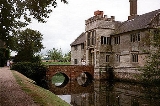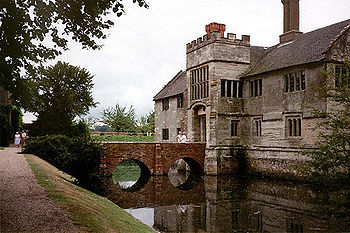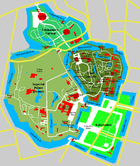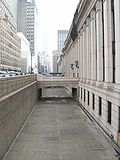
Moat
Encyclopedia

Water
Water is a chemical substance with the chemical formula H2O. A water molecule contains one oxygen and two hydrogen atoms connected by covalent bonds. Water is a liquid at ambient conditions, but it often co-exists on Earth with its solid state, ice, and gaseous state . Water also exists in a...
, that surrounds a castle
Castle
A castle is a type of fortified structure built in Europe and the Middle East during the Middle Ages by European nobility. Scholars debate the scope of the word castle, but usually consider it to be the private fortified residence of a lord or noble...
, other building or town, historically to provide it with a preliminary line of defence. In some places moats evolved into more extensive water defences, including natural or artificial lakes, dams and sluices. In later periods the moat or water defences may be largely ornamental.
Ancient

Ancient Egypt
Ancient Egypt was an ancient civilization of Northeastern Africa, concentrated along the lower reaches of the Nile River in what is now the modern country of Egypt. Egyptian civilization coalesced around 3150 BC with the political unification of Upper and Lower Egypt under the first pharaoh...
ian fortresses. One example is at Buhen
Buhen
Buhen was an ancient Egyptian settlement situated on the West bank of the Nile below the Second Cataract. It is well known for its fortress, probably constructed during the rule of Senusret III, around the year 1860 BC . The site may have been first established as an outpost in Nubia during the...
, a fortress excavated in Nubia
Nubia
Nubia is a region along the Nile river, which is located in northern Sudan and southern Egypt.There were a number of small Nubian kingdoms throughout the Middle Ages, the last of which collapsed in 1504, when Nubia became divided between Egypt and the Sennar sultanate resulting in the Arabization...
. Other evidence of ancient moats is found in the ruins of Babylon, and in reliefs from ancient Egypt, Assyria
Assyria
Assyria was a Semitic Akkadian kingdom, extant as a nation state from the mid–23rd century BC to 608 BC centred on the Upper Tigris river, in northern Mesopotamia , that came to rule regional empires a number of times through history. It was named for its original capital, the ancient city of Assur...
, and other cultures in the region.
Medieval
Moats were excavated around castleCastle
A castle is a type of fortified structure built in Europe and the Middle East during the Middle Ages by European nobility. Scholars debate the scope of the word castle, but usually consider it to be the private fortified residence of a lord or noble...
s and fortifications as part of the defensive system as an obstacle immediately outside the walls
Defensive wall
A defensive wall is a fortification used to protect a city or settlement from potential aggressors. In ancient to modern times, they were used to enclose settlements...
. In suitable locations they might be filled with water. A moat made access to the walls difficult for siege weapons, such as siege tower
Siege tower
A siege tower is a specialized siege engine, constructed to protect assailants and ladders while approaching the defensive walls of a fortification. The tower was often rectangular with four wheels with its height roughly equal to that of the wall or sometimes higher to allow archers to stand on...
s and battering ram
Battering ram
A battering ram is a siege engine originating in ancient times and designed to break open the masonry walls of fortifications or splinter their wooden gates...
s, which needed to be brought up against a wall to be effective. A water-filled moat made the practice of mining, digging tunnels under the fortifications in order to effect a collapse of the defences, very difficult as well.
The word was adapted in Middle English
Middle English
Middle English is the stage in the history of the English language during the High and Late Middle Ages, or roughly during the four centuries between the late 11th and the late 15th century....
from the French motte "mound, hillock" and was first applied to the central mound on which a fortification was erected (see Motte and bailey), and then came to be applied to the excavated ring, a "dry moat". The term moat is also applied to natural formations reminiscent of the artificial structure, and to similar modern architectural features.
Africa
Ancient Nigeria -The Walls of Benin
Walls of Benin
The Walls of Benin were a combination of ramparts and moats, called Iya in the local language, used as a defense of the historical Benin City, formerly of the now defunct Kingdom of Benin and now the capital of the present-day Edo State of Nigeria...
was a combination of ramparts and moats, called Iya, used as a defense of the capital Benin City
Benin City
Benin City, is a city and the capital of Edo State in southern Nigeria. It is a city approximately twenty-five miles north of the Benin River. It is situated 200 miles by road east of Lagos...
in present-day Edo State of Nigeria. It was considered the largest man-made structure lengthwise, second only to the Great Wall of China and the largest earthwork in the world. With more recent work by Patrick Darling, it has been established as the largest man-made structure in the world, larger than Sungbo's Eredo. It enclosed 6,500 km² of community lands. Its length was over 16,000 km of earth boundaries. It was estimated that earliest construction began in 800 AD and continued into the mid 1400's.
The walls are built of a ditch and dike structure; the ditch dug to form an inner moat with the excavated earth used to form the exterior rampart.
The Benin Walls were ravaged by the British in 1897. Scattered pieces of the walls remain in Edo, with material being used by the locals for building purposes. The walls continue to be torn down for real estate developments.
The Walls of Benin City was the world's largest man-made structure.Fred Pearce wrote in New Scientist:
"They extend for some 16,000 kilometres in all, in a mosaic of more than 500 interconnected settlement boundaries. They cover 6,500 square kilometres and were all dug by the Edo people. In all, they are four times longer than the Great Wall of China, and consumed a hundred times more material than the Great Pyramid of Cheops. They took an estimated 150 million hours of digging to construct, and are perhaps the largest single archaeological phenomenon on the planet.
Asia

Japanese castle
' were fortresses composed primarily of wood and stone. They evolved from the wooden stockades of earlier centuries, and came into their best-known form in the 16th century...
s often have very elaborate moats, sometimes with many moats laid out in concentric circles around the castle and a host of different patterns engineered around the landscape. Japanese castles will have up to three of these concentric moats. The outer moat of Japanese castles typically protects other support buildings in addition to the castle.
As many Japanese castles have historically been a very central part of their respective city, the moats have provided a vital waterway to the city. Even in modern times, the moat system of the Tokyo Imperial Palace
Kokyo
is the main residence of the Emperor of Japan. It is a large park-like area located in the Chiyoda area of Tokyo close to Tokyo Station and contains several buildings including the main palace , the emperor left Kyoto Imperial Palace for Tokyo...
comprises a very active body of water, hosting everything from rental boats and fishing ponds to restaurants.
Most modern Japanese castles have moats filled with water, but castles in the feudal period more commonly had 'dry moats' (karahori, 空堀), essentially a ditch. Even today, it is common for mountain Japanese castles to have dry moats.
Moats were also used in the Forbidden City
Forbidden City
The Forbidden City was the Chinese imperial palace from the Ming Dynasty to the end of the Qing Dynasty. It is located in the middle of Beijing, China, and now houses the Palace Museum...
and Xi'an
Xi'an
Xi'an is the capital of the Shaanxi province, and a sub-provincial city in the People's Republic of China. One of the oldest cities in China, with more than 3,100 years of history, the city was known as Chang'an before the Ming Dynasty...
in China; in Vellore
Vellore
Vellore It is considered one of the oldest cities in South India and lies on the banks of the Palar river on the site of Vellore Fort. The city lies between Chennai and Bangalore and the Temple towns of Thiruvannamalai and Tirupati...
in India; and in Southeast Asia, such as at Angkor Wat
Angkor Wat
Angkor Wat is a temple complex at Angkor, Cambodia, built for the king Suryavarman II in the early 12th century as his state temple and capital city. As the best-preserved temple at the site, it is the only one to have remained a significant religious centre since its foundation – first Hindu,...
in Cambodia
Cambodia
Cambodia , officially known as the Kingdom of Cambodia, is a country located in the southern portion of the Indochina Peninsula in Southeast Asia...
and Chiang Mai
Chiang Mai
Chiang Mai sometimes written as "Chiengmai" or "Chiangmai", is the largest and most culturally significant city in northern Thailand. It is the capital of Chiang Mai Province , a former capital of the Kingdom of Lanna and was the tributary Kingdom of Chiang Mai from 1774 until 1939. It is...
in Thailand
Thailand
Thailand , officially the Kingdom of Thailand , formerly known as Siam , is a country located at the centre of the Indochina peninsula and Southeast Asia. It is bordered to the north by Burma and Laos, to the east by Laos and Cambodia, to the south by the Gulf of Thailand and Malaysia, and to the...
.
America
While moats are commonly associated with European castles, they were also developed by North AmericaNorth America
North America is a continent wholly within the Northern Hemisphere and almost wholly within the Western Hemisphere. It is also considered a northern subcontinent of the Americas...
n Indians
Native Americans in the United States
Native Americans in the United States are the indigenous peoples in North America within the boundaries of the present-day continental United States, parts of Alaska, and the island state of Hawaii. They are composed of numerous, distinct tribes, states, and ethnic groups, many of which survive as...
of the Mississippian culture
Mississippian culture
The Mississippian culture was a mound-building Native American culture that flourished in what is now the Midwestern, Eastern, and Southeastern United States from approximately 800 CE to 1500 CE, varying regionally....
as the outer defence of some fortified villages. The remains of a 16th-century moat are still visible at the Parkin Archeological State Park
Parkin Archeological State Park
Parkin Archeological State Park, also known as Parkin Indian Mound, is an archeological site and state park in Parkin, Cross County, Arkansas. Around 1350–1650 CE an aboriginal palisaded village existed at the site, at the confluence of the St. Francis and Tyronza Rivers. Artifacts from this...
in eastern Arkansas
Arkansas
Arkansas is a state located in the southern region of the United States. Its name is an Algonquian name of the Quapaw Indians. Arkansas shares borders with six states , and its eastern border is largely defined by the Mississippi River...
. Further, the term moat was used to describe dry ditches surrounding forts built by colonials or Americans to protect important landmarks, harbors, or cities (see: Fort Jay
Fort Jay
Fort Jay is a harbor fortification and the name of the former Army post located on Governors Island in New York Harbor. Fort Jay is the oldest defensive structure on the island, built to defend Upper New York Bay, but has served other purposes...
on Governors Island
Governors Island
Governors Island is a island in Upper New York Bay, approximately one-half mile from the southern tip of Manhattan Island and separated from Brooklyn by Buttermilk Channel. It is legally part of the borough of Manhattan in New York City...
).
The Mayans also used moats in the city of Becan
Becan
Becan is an archaeological site of the Maya civilization in pre-Columbian Mesoamerica. Becan is located near the center of the Yucatán Peninsula, in the present-day Mexican state of Campeche, about 150 km north of Tikal. The Maya sites of Balamku, Calakmul, Chicanna and Xpuhil are nearby...
.
Modern uses
While moats are no longer a significant tool of warfare, they continue to serve as a defence against certain modern threats such as car bombCar bomb
A car bomb, or truck bomb also known as a Vehicle Borne Improvised Explosive Device , is an improvised explosive device placed in a car or other vehicle and then detonated. It is commonly used as a weapon of assassination, terrorism, or guerrilla warfare, to kill the occupants of the vehicle,...
s and armoured fighting vehicle
Armoured fighting vehicle
An armoured fighting vehicle is a combat vehicle, protected by strong armour and armed with weapons. AFVs can be wheeled or tracked....
s. They also fill a variety of creative contemporary uses.
Installation security
The Catawba Nuclear StationCatawba Nuclear Station
The Catawba Nuclear Station is a nuclear power plant located on a peninsula, called "Concord Peninsula", that reaches out into Lake Wylie, in York, South Carolina...
, for instance, has been constructing a concrete moat around some of the plant (other sides of the plant are bordering a lake). The moat is a part of industry wide added precautions after the September 11, 2001 attacks
September 11, 2001 attacks
The September 11 attacks The September 11 attacks The September 11 attacks (also referred to as September 11, September 11th or 9/119/11 is pronounced "nine eleven". The slash is not part of the pronunciation...
. Related individuals have made a point to claim that the moat is not connected to the new MOX fuel
MOX fuel
Mixed oxide fuel, commonly referred to as MOX fuel, is nuclear fuel that contains more than one oxide of fissile material. MOX fuel contains plutonium blended with natural uranium, reprocessed uranium, or depleted uranium. MOX fuel is an alternative to the low-enriched uranium fuel used in the...
that the plant will be receiving.
"The concrete moat under construction at the station south of Charlotte has little to do with the utility's plans to start burning mixed-oxide fuel containing small amounts of weapons-grade plutonium next spring. Designed to prevent everything from passenger cars to military tanks from getting too close to the reactor, the moat is part of a post-Sept 11, 2001 security upgrade"http://www.nukeworker.com/pictures/displayimage.php?album=98&pos=0
Animal containment
Moats rather than fences separate animals from spectators in many modern zooZoo
A zoological garden, zoological park, menagerie, or zoo is a facility in which animals are confined within enclosures, displayed to the public, and in which they may also be bred....
installations. Moats were first used in this way by Carl Hagenbeck
Carl Hagenbeck
Carl Hagenbeck was a merchant of wild animals who supplied many European zoos, as well as P.T. Barnum. He is often considered the father of the modern zoo because he introduced "natural" animal enclosures that included recreations of animals' native habitats without bars...
at his Tierpark
Tierpark Hagenbeck
The Tierpark Hagenbeck is a zoo in Stellingen, now a quarter in Hamburg, Germany. The collection began in 1863 with animals that belonged to Carl Hagenbeck Sr. , a fishmonger who became an amateur animal collector. The park itself was founded by Carl Hagenbeck Jr. in 1907...
. The structure, with a vertical outer retaining wall rising directly from the moat, is an extended usage of the ha-ha
Ha-ha (garden)
Ha-ha is a term in garden design that refers to a trench, one side of which is concealed from view, designed to allow an unobstructed view from a garden, pleasure-ground, or park, while maintaining a physical barrier in one direction, usually to keep livestock out that are kept on an expansive...
of English landscape gardening.
Zoological research
Researchers of jumping spiderJumping spider
The jumping spider family contains more than 500 described genera and about 5,000 described species, making it the largest family of spiders with about 13% of all species. Jumping spiders have some of the best vision among invertebrates and use it in courtship, hunting and navigation...
s, which have excellent vision and adaptable tactics, built water-filled miniature moats, too wide for the spiders to jump all the way across. Some specimens were rewarded for jumping than then swimming, and others for swimming only. Portia fimbriata
Portia fimbriata
Portia fimbriata, sometimes called the fringed jumping spider, is a jumping spider found in Australia and Southeast Asia. Adult females have bodies 6.8 to 10.5 millimetres long, while those of adult males are 5.2 to 6.5 millimetres long...
from Queensland
Queensland
Queensland is a state of Australia, occupying the north-eastern section of the mainland continent. It is bordered by the Northern Territory, South Australia and New South Wales to the west, south-west and south respectively. To the east, Queensland is bordered by the Coral Sea and Pacific Ocean...
generally succeeded, for whichever method they were rewarded. When specimens from two different populations of Portia labiata
Portia labiata
Portia labiata is a jumping spider found in Sri Lanka, India, Burma , Malaysia, Singapore, Java, Sumatra and the Philippines. In this medium-sized jumping spider, the front part is orange-brown and the back part is brownish...
were set the same task, members of one population worked out for whichever method they were rewarded, while members of the other continued to use whichever method they tried first and did not try to adapt.
Border control
In 2004 plans were suggested for a two-mile moat across the southern border of the Gaza StripGaza Strip
thumb|Gaza city skylineThe Gaza Strip lies on the Eastern coast of the Mediterranean Sea. The Strip borders Egypt on the southwest and Israel on the south, east and north. It is about long, and between 6 and 12 kilometres wide, with a total area of...
to prevent tunnelling from Egyptian territory to the border town of Rafah.
In 2008, city officials in Yuma, Arizona
Yuma, Arizona
Yuma is a city in and the county seat of Yuma County, Arizona, United States. It is located in the southwestern corner of the state, and the population of the city was 77,515 at the 2000 census, with a 2008 Census Bureau estimated population of 90,041....
planned to dig out a two-mile stretch of a 180-hectare (440-acre) wetland known as Hunters Hole, to control immigrants coming from Mexico.
Pest control in Bonsai
As a basic method of pest control in bonsaiBonsai
is a Japanese art form using miniature trees grown in containers. Similar practices exist in other cultures, including the Chinese tradition of penjing from which the art originated, and the miniature living landscapes of Vietnamese hòn non bộ...
, a moat may be used to restrict access of crawling insects to the bonsai.
Lighting and ventilation

James Farley Post Office
The James A. Farley Post Office Building is the main post office building in New York City. Its ZIP code designation is 10001. Built in 1912, the building is famous for bearing the inscription: Neither snow nor rain nor heat nor gloom of night stays these couriers from the swift completion of...
in New York City
New York City
New York is the most populous city in the United States and the center of the New York Metropolitan Area, one of the most populous metropolitan areas in the world. New York exerts a significant impact upon global commerce, finance, media, art, fashion, research, technology, education, and...
allows light and fresh air to reach the basement workspaces.
See also
- DrawbridgeDrawbridgeA drawbridge is a type of movable bridge typically associated with the entrance of a castle surrounded by a moat. The term is often used to describe all different types of movable bridges, like bascule bridges and lift bridges.-Castle drawbridges:...
- Douglas Hogg
- GrachtGrachtThe word gracht is a Dutch term that is encountered by English-speaking people when confronted with Dutch art , Dutch history or tourism...
- Moot hillMoot hillA moot hill or mons placiti is a hill or mound historically used as an assembly or meeting place. In early medieval Britain, such hills were used for "moots", meetings of local people to settle local business. Among other things, proclamations might be read; decisions might be taken; court cases...
sometimes written as Moat Hill.

